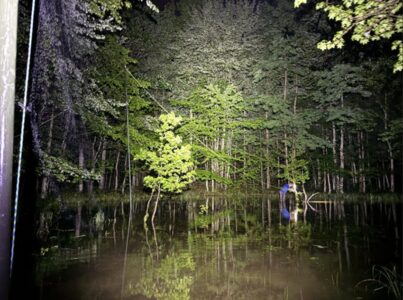‘Bat Blitz’ mission is to find, protect endangered bats in Alabama
In the midst of the deep, thickly wooded forests of Alabama, it’s possible to occasionally spy a real-life “Bat Man.”
Instead of fighting crime, these bat men and women – all trained experts on bats – take part in a “Bat Blitz,” an organized mission to study bat populations across the Yellowhammer State. Researchers also look for signs of white-nose syndrome (WNS) in bats they capture. Since its discovery in the mid-2000s, this deadly fungus has killed millions of bats in the U.S.
During the annual Bat Blitz, researchers spend three nights capturing and counting bats. They also look for signs of injuries or damage to their wings, some of which could be due to WNS.
Most often seen from dusk to dawn, these tiny mammals are critically important to the ecosystem and to human life.
“Bats eat a lot of pests that may otherwise prey on crops,” said Alabama Power Environmental Affairs (EA) Specialist Dylan Shaw. “They keep mosquito numbers down and they’re very important for maintaining ecosystem balance as it relates to insects.”
“Alabama Power is responsible for managing a lot of land in the state,” Shaw noted. “A lot of this may be habitat for bats. We are committed to being good stewards of the resources we manage.”
A bat blitz is an intensive, multinight survey in which researchers come together in a historically under-surveyed part of the state. Shaw and other researchers, including EA Specialists Jeff Baker and Colin Dinken, who are members of Alabama’s Bat Working Group, typically search for bats for several nights. The goal is to gauge the species’ diversity, health and the overall bat population in a local area.
During the blitz, teams of biologists set up extremely fine mist nets arranged between two poles, similar to a volleyball net. Once captured, biologists safely remove bats and identify their species. Researchers also determine whether the animals are male or female and whether they are reproductively active.

Researchers set up nets to catch the bats, which are most active during night and early dusk. (Alabama Power Environmental Affairs)
“We measure the wings to help determine the species and get an idea of the maturity level, then check for signs of white-nose syndrome,” he said. “We can pull the wing out and look for things like holes, which can be an indicator of disease.”
Bat blitzes have been held in the Southeast for more than 20 years. In Alabama, research has been conducted for about 15 years. Neighboring states have their own bat working groups that conduct similar annual bat blitzes. Occasionally, multiple states will team up to host a “regional” bat blitz, similar to the three-day event held in Alabama in August 2022.
“It’s really interesting, because biologists started conducting surveys prior to white-nose syndrome entering the state,” said Shaw, who noted the fungus entered from the Northeast U.S. and slowly crept toward the Southeast.
“We’ve been able to return to some of the sites that were surveyed pre-white-nose syndrome and conduct follow-up surveys to see how populations have responded,” he added. “Unfortunately, we’ve seen some really significant decreases in several species, as much as 90 percent in many cases.”
WNS is now the main threat to bats in North America. The disease, which originated in Europe, was unintentionally introduced to North America and has since spread across many bat species.
Bats spend most of the fall fattening up and use those energy stores to hibernate during the coldest months. Shaw said WNS essentially “overrides” bats’ hibernation system, waking them in the middle of winter when there’s nothing to forage on. The bats must use lots of energy to keep themselves warm.
“They essentially starve to death because they don’t have the resources available to them to keep them alive,” Shaw explained. “WNS has decimated many bat species that reside in caves.”
Findings from annual Bat Blitz studies are used by resource managers, such as U.S. Fish and Wildlife Service and the U.S. Forest Service, to inform management strategies.
“For example, the occurrence information gathered during a blitz is used to update range maps, which show the geographic distribution of species,” Shaw said. “These maps are crucial for conservation efforts, helping us identify areas where species may need additional protection.”
READ MORE:





